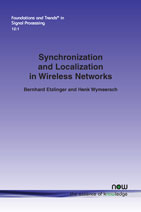Synchronization and Localization in Wireless Networks
By Bernhard Etzlinger, Johannes Kepler University, Austria, bernhard.etzlinger@jku.at | Henk Wymeersch, Chalmers University of Technology, Sweden, henkw@chalmers.se
Abstract
This review addresses the role of synchronization in the radio localization problem, and provides a comprehensive overview of recent developments suitable for current and future practical implementations. The material is intended for both, theoreticians and practitioners, and is written to be accessible to novices, while covering state-of-the-art topics, of interest to advanced researchers of localization and synchronization systems. Several widely-used radio localization systems, such as GPS and cellular localization, rely on time-of-flight measurements of data-bearing signals to determine inter-radio distances. For such measurements to be meaningful, accurate synchronization is required. While existing systems use a highly synchronous infrastructure, such as GPS where satellites are equipped with atomic clocks or cellular localization where base stations are GPS synchronized, most other wireless networks do not have an sufficiently accurate common notion of time across the nodes. Synchronization, either at link or network level, thus has a principal role in localization systems. This role is expected to become more important in view of recent trends in high-precision and distributed localization, as well as future communication standards, such as 5G indoor localization when access points can not be externally synchronized. Since synchronization is generally treated separately from localization, there is a need to harmonize these two fundamental problems, especially in the decentralized network context. In this monograph, we revisit the role of synchronization in radio localization and provide an exposition of its relation to the general network localization problem. After an introduction of basic concepts, models, and network inference methods, we contrast two-step approaches with single-step (simultaneous) synchronization and localization. These approaches are discussed in terms of their methodology and fundamental limitations. Our focus is on techniques that consider practical relevant clock, delay, and measurement models in order to guide the reader from physical observations to statistical estimation techniques. The presented methods apply to networks with asynchronous localization infrastructure and/or to cooperative ad-hoc networks.
Synchronization and Localization in Wireless Networks
Modern day networking and computing systems rely increasingly on knowing the location of the user. These include state-of-the art technologies such as navigation of vehicles and robots, traffic planning, or light control in smart home environments. In the future, even more services will appear. The predominant localization technology currently uses satellite signals but this only works outdoors, is expensive, and consumes considerable power.
Alternative localization technologies have been recently developed using optical, ultra-sound, or radar techniques. All of these require additional hardware components to work effectively. Radio-frequency (RF) localization is a technique that uses communication signals to perform the task without the need for any extra hardware.
This monograph addresses the role of synchronization in radio localization and provides a comprehensive overview of recent developments suitable for current and future practical implementations. The material is intended for both theoreticians and practitioners and is written to be accessible to novices while covering state-of-the-art topics of interest to advanced researchers of localization and synchronization systems.
